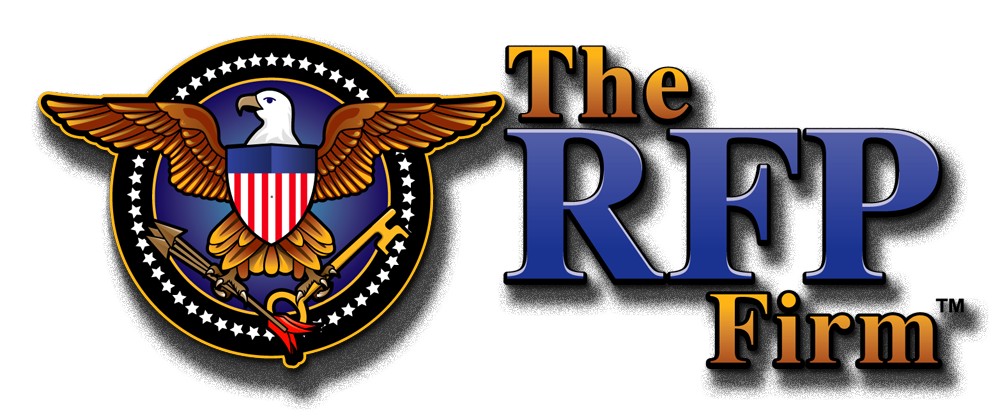Blog
Government & Commercial Proposal Writing Services
 The RFP Firm is expert at writing proposals in Response to Federal and State Government RFP Solicitations that will give you a Competitive Advantage over your competition.
The RFP Firm is expert at writing proposals in Response to Federal and State Government RFP Solicitations that will give you a Competitive Advantage over your competition.


Proposal Writing Services , RFP Proposal Consulting, Government RFP writing
Government RFP Proposal Writing Services
Government & Commercial Proposal Writing Services
 The RFP Firm is expert at writing proposals in Response to Federal and State Government RFP Solicitations that will give you a Competitive Advantage over your competition.
The RFP Firm is expert at writing proposals in Response to Federal and State Government RFP Solicitations that will give you a Competitive Advantage over your competition.

Communicating that you understand of the government agency’s needs for the services requested is extremely important and the first step in gaining confidence in your firm’s ability to deliver the required services. Let them know that you understand why it is important, why it is a timely venture, and why your company is specifically suited to provide the required services.
While every proposal is going to be different, there are some basic strategies and tactics that hold true for almost every proposal consulting project regardless of the subject matter. First, you must understand that your proposal will be setting the stage for the government’s expectations as to how you will execute the contract itself.
Its critical to present your vision for the project up front, along with a schedule or roadmap describing when the various phases will take place in your work plan. While the technical specifics will differ, there are key aspects that are common across most proposals.
The three most important things to think about are convincing your audience that the problem is worth working on, and that this problem deserves resources now, as opposed to other things that might be present. Attention and resources compete to convince them that you are the right one to work on the problem versus other people or groups who may have identified similar problems.
Writing a project proposal can be enjoyable. It is also a crucial part of the project planning process. Plans are not worth much if the planning process is not done correctly.
Proposals are opportunities to think broadly about an agenda and reflect on what issues you think are really important. It is also an opportunity to think long-term, often many years in advance, so think about the biggest problems you really want to solve and the best ways to solve them. Since you have a longer period of time to solve a problem, you can think of the best methods to solve it and the best people to work on it, even if you don't know or know everything about the proper approach now. Thinking about larger problems three to five years in this unconstrained way allows us as researchers to think beyond the next publication and consider how our work fits into a larger picture.
Coordination of deep structure with strategy
Writing a project proposal can seem like a chore or something that is a requirement for the actual job. But that is not the right way to look at it. Instead, I view project proposal writing as part of the project itself.
Developing a coherent proposal requires a lot of time and reflection; in many cases, I spend a lot of time thinking and planning before I put a single word on the page.
Some of the most successful and creative approaches to solving a problem require spending time to understand the deep underlying structure of a problem and to think broadly to see if there are approaches from other disciplines and resources that might be able to help. The best approaches to problems make connections between two or more disjointed domains and require a deep understanding of the structure of a problem to find the right strategies to solve it. The ability to match the deep structure of a problem with the appropriate strategy can lead to significant breakthroughs.
All of these project ideas required both a deep understanding of a problem and extensive thinking about possibilities. Strategies should adapt to the problem. This takes time and the process cannot be rushed. We must consider the process of formulating the problem to be solved and develop a strategy to solve it as one of the most important parts of the job.
Four Key Questions
Every proposal should aim to answer these questions:
The main goal is to convince the reader that there is a problem that needs to be solved and, furthermore, that the world will be a better place if they solve the problem. The ideal is to go even further, i.e., you have to convince the audience that the problem is too important to leave unsolved.
Research proposals often make the mistake of not thinking broad enough. This is partly to blame for hyper-specialized research areas that can look at important issues too narrowly, leading to incrementalism. When reviewing proposals, I first try to understand the meaning of the problem. If the problem is not worth solving, then nothing else matters.
Watch out for "troublesome excavators."
Problem excavators. Especially when writing offers, keep an eye out for excavators, especially from the industry. The proposed project does not necessarily have to have a previously known answer; In particular, it should not be able to be solved by simply hiring software developers. Rather, a good proposal presents a major problem that typically requires the application of tools and techniques from multiple disciplines, as well as thought and experimentation, on a timeline that extends beyond the next few months. The industry has the ability to hire armies of software developers to churn out code quickly. If your proposed solution to the problem is simple and the problem is worth solving, there is a high risk that the industry will solve the problem better and faster.
Convince the reader that the problem you are working on cannot be solved by industry and that spending money researching the problem is the best (or only) way to solve it.
Is Now the Right Time?
The problem you are proposing could be an old problem that is ripe for reevaluation or reexamination due to new circumstances. Or it could be a new problem that arose due to changes in time, circumstances, technology, skills, or data. It is important to know what kind of problem you are posing because your readers will want to know why now is the right time to solve it.
Most likely you are reexamining an old problem in new circumstances or tackling a new problem that hopefully has similarities to old problems. It is good to know what kind of problem you are proposing, as it will help you argue why now is the right time to work on the problem.
Why is now the right time?
Old problem, new circumstances. Most of the problems are not new. Almost every problem you think about or formulates has a prior instance. It may not look exactly like the problem you have in mind, but the chances that the problem you have in mind have no previous analogies or similar problems are infinitesimal. However, even if you propose to work on a very similar problem that has been proposed in the past, the project proposal it may still be worth it. Old problems are often worth looking at again.
And while the problems you may encounter may seem entirely new, they likely have an analogy to problems people have already explored. This is good news because you are not completely lost in the woods while trying to solve the problem. And yet, in such situations, it is even more important to think broadly about possible solutions, since a problem is never completely new, but how analogous problems have been studied or approached can help provide an important point.
Why are you the best choice?
Perhaps one of the most important aspects of proposal consulting is that you and your team get to do the work. You may have convinced the reader that you have identified a difficult problem worth solving, but if you cannot convince your audience that you can solve it, then your chance of success is slim.
You need to create credibility and convince the reader that you are ideally uniquely qualified to do the job you are proposing. Establish your "secret weapon" to solve the problem that others do not have. If possible, build on the successes of your own previous work and build bridges between your previous work and the new project you are pitching. This is where a complicated trade-off comes into play. You have to rely on your past accomplishments to lend credibility to the proposed job, but the proposed work must be visionary enough to encompass three to five years of future work. One way to do this is to include some preliminary work in the proposal to show that your vision is feasible and that you are qualified to execute it. This is not the time to be humble.
Your team and associations. No one person solves important and challenging problems alone. Therefore, it is also important to articulate what resources, in the form of other people, organizations, data, etc., you will bring to your project. Therefore, your proposal should list other people (e.g., experts, strategic partners, direct collaborators) with whom you would like to collaborate on the project, including the role these people will play in your project.
From a logistical perspective, the more comprehensive your plan is for how the different team members and puzzle pieces fit together, the further along you are in the plan. Building a successful team and partnerships behind your project takes time, but will ultimately result in a better project, even if you are ultimately the driving force and leader of the project.
Sell the Ultimate Outcome
If you want people to enjoy reading your research proposal, then the proposal must tell a good story which, of course, has to be of a certain type and written in a certain style One of my favorite recipes for telling a story is to build the context of the problem, explain why the problem is important and difficult to solve, and then draw a stark and succinct contrast between your approach and any previous approach.
When providing consulting services for proposals, tell the reader what makes your work stand out and why it is likely to succeed where others have failed or fallen short. In fact, he paints his work as so promising and so different from the approach of others that it would be foolish not to fund the proposed work because no one else will, and failure to do so could result in a missed opportunity that would lead to a breakthrough.